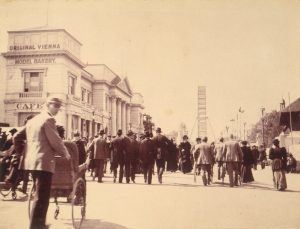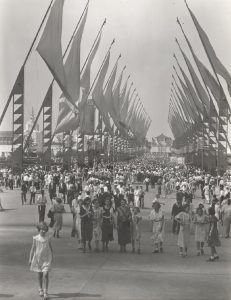Chicago’s World’s Fairs
In the nineteenth and twentieth centuries, world’s fairs and expositions celebrated the past while introducing visions of the future. Chicago hosted the World’s Columbian Exposition in 1893 and the A Century of Progress World’s Fair in 1933–34.
The lessons in this unit cover the art and architecture of the 1893 World’s Columbian Exposition; the connections between agriculture, advertising, and mail-order catalogues as expressed at the World’s Columbian Exposition; transportation as a symbol of technological breakthrough at the 1933–34 A Century of Progress; and the correlation between art and science at the 1933–34 A Century of Progress.
 Lesson 1: What is Art?
Lesson 1: What is Art?
Planning a Public Art Program
This lesson aims to familiarize students with the public art of the World’s Columbian Exposition. Students will explore public art by asking: Who decides what is tasteful and what is offensive? How do decisions made by fair organizers still dictate the city’s attitudes toward public art? Students will also identify the fair’s “masterful illusion” and study how it continued to influence urban institutions and planning far into the future. Download What is Art? Planning a Public Art Program.
Lesson 2: The World’s Fair of 1893: A Tribute to Agriculture and Advertising
The World’s Fair of 1893 brought thousands of rural visitors to Chicago. These visitors celebrated the past and were awed by visions of the future. They explored the agricultural advances on display in the fair’s Agriculture Building and visited the stores that provided them with their mail-order goods. During this lesson, students will examine explore the appeal of the urban world to rural Americans and the power of advertising. Download The World’s Fair of 1893: A Tribute to Agriculture and Advertising.
Lesson 3: Planes, Trains, and Automobiles: The Impact of Transportation
A Century of Progress focused on the advances of civilization during the century following Chicago’s incorporation. The fair highlighted new technology, specifically the role of transportation in modern society. This lesson helps students to identify the modes of transportation on display at the fair and discuss how the variety of displays promoted escapism and travel. Students will also research transportation highlights of the era and consider the changing nature of technology in 1933. Download Planes, Trains, and Automobiles: The Impact of Transportation.
 Lesson 4: Celebrating Modernism at the A Century of Progress World’s Fair
Lesson 4: Celebrating Modernism at the A Century of Progress World’s Fair
Why did A Century of Progress organizers fully embrace modernism? Why were many of the buildings and exhibits future-oriented? During this lesson, students will discover the answers to these questions by identifying artifacts that reflect modernist ideas, interpreting photographs of modernist fair buildings, finding examples of modernism in their lives, and studying the impact of modernism on the history of design. Download Celebrating Modernism at the A Century of Progress World’s Fair.

